A proteomic study of mitotic phase-specific interactors of EB1 reveals a role for SXIP-mediated protein interactions in anaphase onset
- PMID: 25596275
- PMCID: PMC4365484
- DOI: 10.1242/bio.201410413
A proteomic study of mitotic phase-specific interactors of EB1 reveals a role for SXIP-mediated protein interactions in anaphase onset
Abstract
Microtubules execute diverse mitotic events that are spatially and temporally separated; the underlying regulation is poorly understood. By combining drug treatments, large-scale immunoprecipitation and mass spectrometry, we report the first comprehensive map of mitotic phase-specific protein interactions of the microtubule-end binding protein, EB1. EB1 interacts with some, but not all, of its partners throughout mitosis. We show that the interaction of EB1 with Astrin-SKAP complex, a key regulator of chromosome segregation, is enhanced during prometaphase, compared to anaphase. We find that EB1 and EB3, another EB family member, can interact directly with SKAP, in an SXIP-motif dependent manner. Using an SXIP defective mutant that cannot interact with EB, we uncover two distinct pools of SKAP at spindle microtubules and kinetochores. We demonstrate the importance of SKAP's SXIP-motif in controlling microtubule growth rates and anaphase onset, without grossly disrupting spindle function. Thus, we provide the first comprehensive map of temporal changes in EB1 interactors during mitosis and highlight the importance of EB protein interactions in ensuring normal mitosis.
Keywords: Cell cortex; Kinetochore; Microtubule; Mitosis; Plus-end.
© 2015. Published by The Company of Biologists Ltd.
Conflict of interest statement
Figures
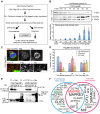
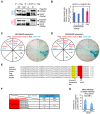
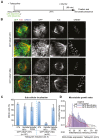
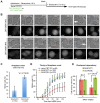
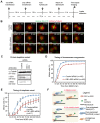
Similar articles
-
Molecular requirements for the inter-subunit interaction and kinetochore recruitment of SKAP and Astrin.Nat Commun. 2016 Apr 20;7:11407. doi: 10.1038/ncomms11407. Nat Commun. 2016. PMID: 27095104 Free PMC article.
-
Mitotic regulator SKAP forms a link between kinetochore core complex KMN and dynamic spindle microtubules.J Biol Chem. 2012 Nov 16;287(47):39380-90. doi: 10.1074/jbc.M112.406652. Epub 2012 Oct 3. J Biol Chem. 2012. PMID: 23035123 Free PMC article.
-
Kebab: kinetochore and EB1 associated basic protein that dynamically changes its localisation during Drosophila mitosis.PLoS One. 2011;6(9):e24174. doi: 10.1371/journal.pone.0024174. Epub 2011 Sep 2. PLoS One. 2011. PMID: 21912673 Free PMC article.
-
Merotelic kinetochores in mammalian tissue cells.Philos Trans R Soc Lond B Biol Sci. 2005 Mar 29;360(1455):553-68. doi: 10.1098/rstb.2004.1610. Philos Trans R Soc Lond B Biol Sci. 2005. PMID: 15897180 Free PMC article. Review.
-
Prometaphase.Semin Cell Dev Biol. 2021 Sep;117:52-61. doi: 10.1016/j.semcdb.2021.06.004. Epub 2021 Jun 12. Semin Cell Dev Biol. 2021. PMID: 34127384 Review.
Cited by
-
Counteraction between Astrin-PP1 and Cyclin-B-CDK1 pathways protects chromosome-microtubule attachments independent of biorientation.Nat Commun. 2021 Dec 1;12(1):7010. doi: 10.1038/s41467-021-27131-9. Nat Commun. 2021. PMID: 34853300 Free PMC article.
-
Aurora-B kinase pathway controls the lateral to end-on conversion of kinetochore-microtubule attachments in human cells.Nat Commun. 2017 Jul 28;8(1):150. doi: 10.1038/s41467-017-00209-z. Nat Commun. 2017. PMID: 28751710 Free PMC article.
-
Tipping the spindle into the right position.J Cell Biol. 2016 May 9;213(3):293-5. doi: 10.1083/jcb.201604075. Epub 2016 May 2. J Cell Biol. 2016. PMID: 27138251 Free PMC article.
-
Quantitative analysis of sensitivity to a Wnt3a gradient in determination of the pole-to-pole axis of mitotic cells by using a microfluidic device.FEBS Open Bio. 2018 Nov 9;8(12):1920-1935. doi: 10.1002/2211-5463.12525. eCollection 2018 Dec. FEBS Open Bio. 2018. PMID: 30524943 Free PMC article.
-
An unconventional interaction between Dis1/TOG and Mal3/EB1 in fission yeast promotes the fidelity of chromosome segregation.J Cell Sci. 2016 Dec 15;129(24):4592-4606. doi: 10.1242/jcs.197533. Epub 2016 Nov 21. J Cell Sci. 2016. PMID: 27872152 Free PMC article.
References
-
- Ban R., Matsuzaki H., Akashi T., Sakashita G., Taniguchi H., Park S. Y., Tanaka H., Furukawa K., Urano T. (2009). Mitotic regulation of the stability of microtubule plus-end tracking protein EB3 by ubiquitin ligase SIAH-1 and Aurora mitotic kinases. J. Biol. Chem. 284, 28367–28381. 10.1074/jbc.M109.000273 - DOI - PMC - PubMed
LinkOut - more resources
Full Text Sources
Other Literature Sources

